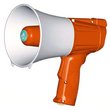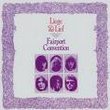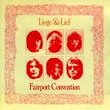|
|

Speakers' corner Following up our retroscope series of 2006 and 2007 - here's the New Speakers' corner! Luna Kafé's focused eye on great events, fantastic happenings, absolute milestones, or other curious incidents from the historic shelves/vaults of rock. This moonth we're setting the Lunar spotlight on another 40 year old - another dear old LK jukebox favourite, from the ...uh Premier, no!, Champions Liege of music. Hello folk!
Fairport Convention These days it is 40 years since the Rolling Stones' Altamont incident and 30 years since the release of Pink Floyd's The Wall and London Calling by The Clash. But let's have a listen to another old classic instead, 40 years old. Many consider Liege & Lief to be the most influential folk-rock album ever, and it probably is. At first listen, though, it doesn't sound neither that original nor outstanding. It reminds of lots of other European folk-rock albums of the last four decades. Fairport was heavily inspired by American singer songwriters and the West Coast at first. Someone labeled them the English Jefferson Airplane. Something changed in 1968, probably when Sandy Denny joined the band after the self titled debut album had been recorded. She had sung in folk clubs for several years and had briefly joined the folk band (at the time) The Strawbs in 1967. Fairport continued with a share of cover versions of songs by Bob Dylan and other Americans, but Fairport's versions sounded more and more like English folk as time went by. The band was deeply impressed by The Band's debut Music From Big Pink and decided, as producer and manager Joe Boyd puts it in his autobiography White Bicycles: 'to create a repertoire as English as Big Pink was American - to turn a rebuke into an inspiration'. Bass player Ashley Hutchins went to the folk archives, particularly the Cecil Sharp House, and found suitable traditional British songs and melodies for them. Several of them were well known to Sandy Denny and new member and fiddler Dave Swarbrick who'd also been part of the English folk-scene for several years. Sandy described what they were into to the New Musical Express before the recordings of Liege & Lief started: 'almost straight folk, only electric - heavy traditional folk music'. I guess the concept folk-rock was invented in the wake of the album. Folk music played with electric guitars and bass, drums and, not least, fiddle. Liege & Lief was probably the first full-blooded album of its kind, the standard, the one most other folk-rock albums might be compared with ever since, and none has ever quite matched. There still remains a slight American country feel to some of the performances, the guitars in particular, I think. The album is centred around two long epic Scottish traditional songs, one on each side of the original LP, and a couple of shorter ones. Telling stories about lust, sex, deceit, violence, death and magic. You know, like your average rock'n'roll lyrics, but expressed in a much more dramatic and cunning way. We also have the obligatory medley of reels and jigs, and a few self penned songs, in the same style, more or less, as the others. But, we're in for a lot more. This line-up of Fairport is the most classic one, though it didn't last more than about five months. The band almost folded after a tragic accident in the early hours of May 12 1969 on the motorway back to London from a gig in Birmingham. Fairport's talented drummer Martin Lamble, only 19 years old, and Richard Thompson's American girlfriend Jeannie Franklyn were killed and several of the others in the van hurt. Eventually the remaining quartet of Richard Thompson (guitar), Simon Nicol (guitar), Ashley Hutchins (bass) and Sandy Denny (vocals) regrouped during the summer at a big country manor rented by Joe Boyd and regained the spirit along with new recruits Dave Mattacks (drums) and Dave Swarbrick (fiddle and viola).
The most profiled songs of Liege & Lief, "Matty Groves" and "Tam Lin" with numerous verses might have sounded weary with a less qualified gang of 'rolling minstrels'. There are plenty of exquisite instrumental details that develop as the verses pass by (both songs) and also after the story (and life) of "Matty Groves" has ended. Especially due to the guitars and fiddle. The same goes for the rest of the songs. Plenty to indulge in for as long as you please. The sextet played a couple of concerts before the album was released. But Sandy at first wanted to back out when they were to fly to a gig in Copenhagen. It seemed her fear of flying had developed after the car accident, even though she hadn't been in the van when it crashed. Also, she wanted to concentrate on her own songwriting rather than interpreting old songs which she had learned from her Scottish grandma and sung for years anyway. So off she went with her boyfriend Trevor Lucas and formed Fotheringay. Listening to her songs - like "Fotheringay" (the song that is, that opened her first album with Fairport, What We Did On Our Holidays) and her signature song "Who Knows Where The Time Goes", especially the version on Unhalfbricking - it's an understandable choice. They and others that followed later on are even more mesmerising than anything on Liege & Lief. Though Liege & Lief as an entity is in a league of its own, compared to any other album she was involved in. Ashley Hutchins, on the other hand, wanted to indulge more in the traditional British folk material than the other boys and quit at the same time to start the other touring force of British folk-rock of the 1970s and onwards Steeleye Span. The remaining quartet recruited yet another Dave - Dave Pegg on bass, toured America and released one more successful album, Full House, based on the same formula as Liege & Lief before Richard Thompson also called it a day. He left in January 1971 to concentrate on a solo and duo carreer that he has kept going to this very day. By the end of the year and two more albums, last founding member Simon Nicol had also quit. But the Fairport ship sailed on, including Sandy and most of the boys from Fotheringay for a while. Simon Nicols rejoined a few months after Sandy had left for the second time. The band folded for some years by the end of the 1970s, but has kept recording and touring again since 1986. None of the recordings can match what the band did in 1969, though. As Nigel Williamson noted in The Times: 'Not only did Fairport Convention invent English folk-rock but they effectively destroyed it, too. Nobody could top the electrified versions of trad ballads such as "Tam Lin" and "Matty Groves" on their classic, genre-defining Liege & Lief - after that there was nowhere left to go.' Amazingly, the album was recorded in mere six days spread over the second half of October and early November 1969 at Joe Boyd's Sound Techniques studio in Chelsea, London (were the majority of the best British folk rock albums of that era were recorded, and a few pop gems, too, including Pink Floyd's first two singles). Mostly live in the studio, I suspect. Even more amazingly, the sessions included three more songs that could easily have made it to the album. Though the pop oriented version of The Byrds' "Ballad Of Easy Rider" (taken from the soundtrack of the Easy Rider movie that was brand new at the time) wouldn't quite have matched the otherwise very British folk songs of the album. "Sir Patrick Spens" was a full blown folk-rocker that was recorded anew for the next album Full House the following year. Most amazingly, the best song of the sessions wasn't even released until several years later. It's a very sparse"The Quiet Joys Of Brotherhood" another traditional with lyrics by American writer and folk singer Richard Fariña, up the same street as "Reynardine" only even more cultivated. It's a fantastic rendition. Two takes of the song, lasting six and eight minutes respectively, have survived and were released on a deluxe version of Liege & Lief in 2007 and three years later on the massive Sandy Denny boxed set. Especially the shortest version, the fourth take, is sublime. As said when we checked out the box: 'A strange sounding guitar, not quite of this world, dramatic partly repetitive tam-tams, drone'ish violin and The Lady's chanting above it all. Spine-chilling!' Oh yeah, it's the best song Fairport ever recorded! Sandy Denny gave the song another go on her second solo album Sandy in 1972. It still sounds great, but don't reach the same hights as in October 1969. At Fairport's annual Cropredy Festival in 2006 the surviving members of the Liege & Lief line-up and producer Joe Boyd received gold discs to commemorate the huge sales of the album during the years. At the festival the following year, they performed the entire album live for the first (and so far last) time. There are several versions of the album to choose between. The deluxe edition on CD from 2007 mentioned above includes one disc with the original album and a second with the three songs that didn't make it to the album and a BBC John Peel session recorded prior to the album sessions. It even includes versions of "The Lady Is A Tramp" and "In Other Words (Fly Me Too The Moon)" by Richard Rogers and Lorenz Hart, lightyears away from the contents of Liege & Lief. There are shorter and cheaper versions available on CD, too, and the album was also relaunched on vinyl not long ago. When I want to listen to the original album, I stick to my old Island Records vinyl copy that Joe Boyd signed earlier this year when he visited Oslo... And by the way: Liege and lief from ancient English mean loyal and ready, a pledge made by peasants to the lord of the manor. Copyright © 2009 JP
|
| © 2011 Luna Kafé |

 The latter Dave had helped out on a few tracks on Fairport's previous album Unhalfbricking. Not least the epic traditional "A Sailor's Tale", an 11 minutes plus mixture of British and Indian folk and American West Coast rock. The closest Fairport ever got to "The End" by The Doors, so to speak.
The song included some sparkling fiddle and guitar interplay that was further developed on Liege & Lief. It doesn't do any harm that the 20 year old Richard Thompson already was one of the greatest guitarists of all times, and - even better - one of the very few guitarists who didn't - and still doesn't - overtly try to expose the fact. Check out his tremolo'ish guitar, especially the short solo, of "Crazy Man Michael". Only one example... The excellent guitar interplay by Thompson and Nicol is less audible than on previous albums, alas, due to the inclusion of the fiddle. We mustn't forget the inventive drumming of Dave Mattacks and Ashley Hutchins' ditto bass-lines. And of course, there is Alexandra Elene MacLean Denny with the voice every folk-rocker can only dream of. It perfectly matches the quicker songs here, especially the opening "Come All Ye" in front of the male choir. But it's in
the quieter moments it really turns magic. Check out the spine-chilling stuff of "Reynardine" only accompanied by discreet cymbals and even more discreet guitars and bass. "Farewell, Farewell" written by Richard Thompson and "Crazy Man Michael" by Thompson/Swarbrick are more conventionally arranged, but still has the same touch, unreachable for almost any other artist
I suspect. Pentangle recorded a traditional song called "Willy O'Winsbury" on their excellent 1972-album Solomon's Seal, learned from Anne Briggs, with the same melody as "Farewell, Farewell". A subdued acoustic version, in contrast to Fairport's somewhat more proud and electric one. Thus it seems Richard only wrote the words for the latter.
The latter Dave had helped out on a few tracks on Fairport's previous album Unhalfbricking. Not least the epic traditional "A Sailor's Tale", an 11 minutes plus mixture of British and Indian folk and American West Coast rock. The closest Fairport ever got to "The End" by The Doors, so to speak.
The song included some sparkling fiddle and guitar interplay that was further developed on Liege & Lief. It doesn't do any harm that the 20 year old Richard Thompson already was one of the greatest guitarists of all times, and - even better - one of the very few guitarists who didn't - and still doesn't - overtly try to expose the fact. Check out his tremolo'ish guitar, especially the short solo, of "Crazy Man Michael". Only one example... The excellent guitar interplay by Thompson and Nicol is less audible than on previous albums, alas, due to the inclusion of the fiddle. We mustn't forget the inventive drumming of Dave Mattacks and Ashley Hutchins' ditto bass-lines. And of course, there is Alexandra Elene MacLean Denny with the voice every folk-rocker can only dream of. It perfectly matches the quicker songs here, especially the opening "Come All Ye" in front of the male choir. But it's in
the quieter moments it really turns magic. Check out the spine-chilling stuff of "Reynardine" only accompanied by discreet cymbals and even more discreet guitars and bass. "Farewell, Farewell" written by Richard Thompson and "Crazy Man Michael" by Thompson/Swarbrick are more conventionally arranged, but still has the same touch, unreachable for almost any other artist
I suspect. Pentangle recorded a traditional song called "Willy O'Winsbury" on their excellent 1972-album Solomon's Seal, learned from Anne Briggs, with the same melody as "Farewell, Farewell". A subdued acoustic version, in contrast to Fairport's somewhat more proud and electric one. Thus it seems Richard only wrote the words for the latter.